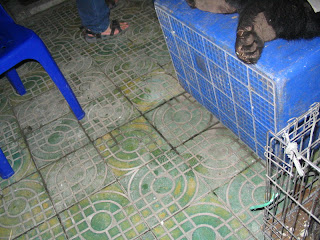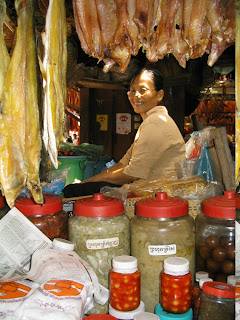With the Temiar Orang Asli as guides, LIZ PRICE treks into one of the last unexplored rainforests in Malaysia, the Belum Temengor in Perak, and bides for sights of rare large mammals.
[published on Wildasia.net 15 June 2002]
THERE are not many places left in Peninsular Malaysia which have been unexplored, but Belum may be one such locality.
Belum comprises a large area of virgin forest in northern Perak and although a few areas are now opened up for tourism, the remainder of the Belum area is inaccessible and seldom visited, as it still remains a security area. This is left over from the days when it was a black area, due to the activities of the Communist Party of Malaya (CPM).
The CPM engaged in guerilla warfare against the Malayan government. The govemment declared a State of Emergency which lasted from 1948 until 1960. During this time there were many skirmishes between the authorities and the communist bandits and most of the mountainous and forested areas of Semenanjung were known as black areas, where the security forces were operating. The CPM finally surrendered in 1989 and it was only in 1991 that the curfew in Belum was lifted.
Prior to the 1990s, Belum had been largely unexplored, and it was only when the Malaysian Nature Society began a two-year scientific expedition there in 1993 that it was realised how rich Belum Forest is in terms of flora and fauna. There is virgin forest with valleys and mountains, crystal clear streams, waterfalls, and a few limestone outcrops. The area is inhabited by the Orang Asli and there are many wild animals especially the larger mammals rarely seen now in other parts of Malaysia, such as tiger, elephant, seladang, bears and deer.
Belum is in Ulu Perak and includes the Temengor and Belum Forest Reserves covering an area of over 113,000ha . It straddles the East - West highway. Today the tourist areas are those in the south, at Pulau Banding and Sungai Kenyir. People can enter with a special permit, but the easiest way is to join a tour group. So I went along with Yusof Aziz from Try Adventures, an adventure outfit that deals in specialised tours to the more ulu areas.
The adventure began in the small town of Gerik. From there, we drove 38km to Temengor Dam, going past the smaller lake of Bersia. The road was littered with elephant dung, obviously these creatures had been in the area recently. At the dam, we transferred to two boats and set off on the one hour ride across the lake. At one stage Yusof told us we were just passing over the site of a village, which was drowned when the dam was created in 1978.
Of course there was nothing to be seen. A couple of limestone outcrops caught my eye, but there was no sign of any caves. I noticed there were very few dead trees sticking up out of the water, whereas on a previous visit to the Sungai Halong area, dead trees were a part of the landscape. We landed at Sungai Kenyir, one of the southern fingers of the lake. There is an Orang Asli village close by. The Temiar tribespeople are very shy and gentle, but amazingly strong. Three of these Temiars accompanied our group as guides/porters. One of them was laden with a full rucksack with three tents tied -- I tried to lift the pack, and could hardly raise it off the floor let alone carry it for three hours.
The trek to our camping site took about three hours at a moderately slow pace, the only obstacles being one hill and six river crossings. In fact, we had to do the first crossing immediately upon starting, even before we entered the forest. The water was amazingly clear, such a treat to see. But the current was deceptively strong and the safest way to cross was to hold hands and form a human chain. No one wanted an unexpected dunking whilst laden with luggage, so crossing in twos or threes proved to be the best way.
As we trekked further in, we soon noticed the differences in vegetation in various areas. One of our guides, Ramli, said this area is known as the Bamboo Area, because of these abundant plants growing all around.
Bamboo is a member of the grass family, and is one of the most versatile and useful of all the plants in the forest. It can be used for constructing shelters and furniture, as water containers and cooking pots, utensils, musical instruments and, of course, as food. Ramli knows this forest well, having served here during the Emergency days, so he was a mine of useful and interesting information.
We were shown wild Tongkat Ali, medicinal herbs, lianas which contain water safe to drink, wild bananas and gingers. Gingers are among the flashier members of the plant world, with showy flowers, and some have red coloured canes with dark red inflorescences on the stem. The dipterocarp trees are impressive through their sheer size, with straight trunks piercing the sky high above. We saw meranti, chegal and keruing.
Unfortunately there was no sign of any animals at all except for leeches. These made their presence known, in fact they were everywhere. They must have been very hungry and we donated much blood to them. For some of the real city dwellers amongst the group, it was their first encounter with these wriggly blood suckers, and it was interesting to watch their reactions as the leeches latched on to their human prey. Leeches are actually quite interesting, with their 34 internal body segments, 10 eyes and three horny jaws. Not forgetting the muscular suctional disk at each end of the body. Seeing leeches is a good sign that there are other mammals living in the area, so it shows that Belum has a resident fauna population.
Our camp was set up by the river. The open air bathroom had an abundance of clear pure free-flowing water, admittedly rather cold, but so clean you can safely drink it straight from the river. Dinner was prepared and the Orang Asli started a fire, using bamboo kindling. That night we drifted off to sleep lulled by the sounds of the river surging by.
The next day we trekked up to Kelawah waterfalls. There are a series of eight waterfalls, and we went as far as the second. Many people swam in the pool at the base of the fall, but the water was definitely chilly. It was cold even just sitting around by the fall as the wind was blowing the spray. Despite the cold, there is something fascinating sitting and staring at water, especially when faced with such a beautiful fall as this. We were mesmerised by the beauty of the place. However we moved to a more sheltered spot for lunch, and a couple of us climbed up to the top of this fall to look down on the others sitting below.
The following day, we trekked back to Kuala Kenyir and that evening the Orang Asli arranged a bersewang (traditional dance) for us. The women sing and play instruments made out of differing lengths of bamboo which are banged on a log, whilst the men dance. Of course our group was expected to join in with the merrymaking and were given hats made from coconut leaves.
On the final day, we visited the Orang Asli village as the doctor in our group was asked to look at one of the village elders. The bamboo houses were perched high above the lake, with a few food crops growing between the houses. As we headed back for the Temengor Dam, we stopped at Syra Tersau which is a small sulphur lake and hot springs. Animals come here to drink the water, and there were signs that elephants had been recent visitors. Our boats then carded us back across the lake, homeward bound. Our visit was made all the more enjoyable and fun with having such knowledgeable guides like Yusof and Ramli explaining the secrets of the forest to us city dwellers. Between them, they were a mine of information as they certainly knew the jungle and were willing to share with us their knowledge. They were also very concerned about group safety and made sure everyone was safe especially when doing the river crossings. Thanks guys.
© Liz Price




.JPG)






































































